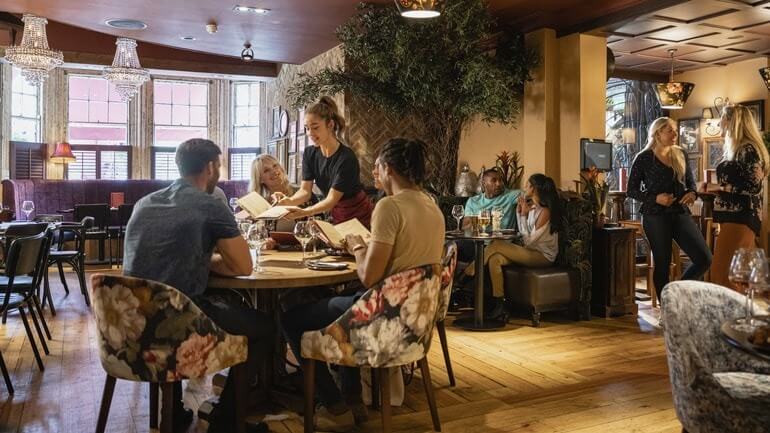Could no-show fees be the key to reducing restaurant reservation no-shows and recouping lost profits? This is a question currently facing many restaurateurs.
Although restaurants typically offer reservations for free, this system does nothing to protect venues when diners fail to uphold their end of the agreement. Because diners don’t face any consequences if they don’t honor a reservation, they don’t have an incentive to cancel the booking if they’ve made other plans. The problem is, if a party doesn’t cancel their reservation, the restaurant loses money by holding a table open for guests who won’t show up.
And that’s where no-show fees come in. Requiring collateral to hold a table could mitigate the consequences of restaurant reservation no-shows, and make them less common. While today’s technology makes it easier than ever for restaurants to add no-show fees, the practice actually dates back to the 18th century.
According to the Atlantic, people used to reserve private dining rooms at restaurants to entertain guests, as this was easier than securing the help, dinnerware, and accessories needed to successfully throw a dinner party at home. The food was typically ordered and paid for in advance of the meal.
No-show fees are a modern take on this centuries-old tradition. Instead of prepaying for a meal in full, diners put a card on file or pay a small “down payment” to secure a table. In this guide to restaurant reservation no-show fees, you’ll learn:
- What is a no-show free
- The benefits of no-show fees
- The drawbacks of charging no-show fees
- Tips for implementing no-show fees at your restaurant
What Is a No-Show Fee?

In order to charge a no-show fee, a restaurant will ask for a customer’s card information to book a table. If the party fails to show up or cancels after the restaurant’s cancellation period, a “no-show fee” is charged to the customer’s credit card.
No-show fees don’t usually cover the cost of a whole meal, but they are usually significant enough to encourage customers to uphold bookings or cancel them within the cancellation window, which gives restaurants time to find another party to fill the reservation.
The best restaurant reservations systems, like TouchBistro Reservations, make it easy to implement no-show fees. TouchBistro Reservations makes it possible to set how much to charge in case of a no-show, decide whether to charge a fee per reservation or per person, and write and publish a customer-facing no-show policy on your online booking page to avoid confusing diners. It also lets you build guest profiles to get to know your customers better over time and provide them with personalized service on every visit.
Restaurant Reservation Deposits
Instead of no-show fees, some restaurants may charge a reservation deposit to secure a restaurant reservation. A restaurant reservation deposit is money paid to a restaurant to reserve a table, or collateral offered to secure a restaurant reservation. For example, a deposit could involve a customer paying $20 per person in their party to book a table.
Most restaurants charge between $20 and 40 per person for reservation deposits. For example, Washington, D.C.-based Thip Khao, a MICHELIN Guide Bib Gourmand pick, requires a $20 per person deposit to make a reservation. Philadelphia’s Kalaya, a James Beard Award nominee and one of Food & Wine Magazine’s Best New Restaurants winners, also has a $20 per seat deposit policy. Both restaurants refund the deposit when you check in for your meal. Suraya, another Philadelphia James Beard Award nominee, charges a $40 per guest no-show fee.
Reservation Deposits for Events and Catering
Restaurants also use deposits to secure events or catering jobs. Deposits let customers lock in bigger events, like a venue buyout, or for large catering orders. After all, the restaurateur is closing (at least part of) their restaurant down to business for a partial or full buyout, so they need to guarantee that they’ll make money.
Most restaurants use contracts for events and catering jobs, but if the client backs out, the legal fees to pursue that loss of income can be too costly to be worth it. As a result, deposits can serve as an important financial safety net.
The Benefits of No-Show Fees
Intrigued by the concept of no-show but not quite sure if it’s right for your restaurant? Here are several benefits of reservation no-show fees.
Reduces restaurant reservation no-shows
When reservations are free, diners may make them without planning to commit, or may make reservations at several restaurants to keep their options open, and end up not canceling them.
Implementing no-show fees will greatly reduce no-shows because there’s a financial consequence attached to missing the booking or failing to cancel with adequate notice.
Acts as financial safety nets
No-shows are bad for business. When you hold a table for a reservation, it’s blocked from others who may be interested in booking the table for the same time or from parties walking in at that time. If the reserving party doesn’t show up, your restaurant loses money that someone else could’ve given you had you left the table open, which could have devastating consequences.
In fact, the average no-show rate is 20%. That means that if your restaurant generates $2,000 in revenue on a typical day with 100% capacity, you could lose up to $400 per night, or almost $150,000 per year, if one in five reservations doesn’t show up. No-show fees help recoup some of the money you’re losing from a party failing to uphold their reservation.
To provide even greater financial security, some reservation systems allow you to ask guests to prepay for the whole meal in order to book. Toronto’s Edulis, a top-ranking institution on Canada’s 100 Best list, for example, requires full prepayment for meals at a rate of $85 per person for lunch and $180 per person for dinner.
If a party doesn’t show up despite a no-show fee AND you’re able to fill that table with walk-in guests, then you could make money off of the no-show fee, rather than just cushioning a loss.
Helps provide job security for staff
As a restaurateur, you’ve probably had to send staff home at some point because the restaurant wasn’t as busy as expected. With reservation no-show fees, you’ll need to do that less often because you’ll have more of a financial cushion to help you keep paying wages. No-show fees are especially important during a labor shortage, when retaining the staff you have is crucial.
The Drawbacks of Charging Fees for No-Shows
These are a few downsides of no-show fees to consider before implementing them.
Customers aren’t used to “paying” for reservations
Reservations are typically free in the restaurant industry, so diners may not be used to putting down a credit card to book a table. Customers may be upset about the prospect of a no-show free when you first introduce the policy. However, they’ll get used to it over time, especially since no-show fees have grown in popularity in the wake of the pandemic.
Extra fees might ward off customers
If there’s a risk of being charged a fee for not showing up, diners may opt to avoid booking a reservation altogether. They may opt for a restaurant that offers a free booking instead. Ultimately, you could see fewer reservations with no-show fees in place, but that doesn’t mean that you won’t fill those tables with walk-in guests.
Fees may lead to more questions
If customers are surprised by your no-show policy while making a reservation online, they may call your restaurant to learn more or to find a way around it.
To prepare for an influx of phone calls, you may want to prepare a pre-recorded message on your answering machine that clarifies the policy so your staff isn’t tied up answering the same questions over and over again on the phone when they could be serving guests or taking takeout orders.

3 Tips for Implementing No-Show Fees at Your Restaurant
If you’ve decided that you want to implement no-show fees for restaurant reservations, there are several things you can do to ensure they work for your business.
1. Require fees for larger party sizes
If you’re wary of introducing no-show fees for parties of all sizes, experiment with making them mandatory for larger parties only – such as those with six or more people – as no-shows for large groups make the biggest dents in profits.
2. Implement no-show fees for peak times
Alternatively, or in conjunction with your large-party no-show fee, you can charge no-show fees to book tables during peak times – such as during dinner on weekends or brunch – when restaurant reservation no-shows can really affect business.
3. Make your no-show policy very clear
To avoid upsetting customers and ending up with bad reviews, explain your no-show policy very clearly during the booking process for reservations made online, over the phone, and in-person at your restaurant.
That means displaying your policy front and center on your website and reservations page, rather than hiding it in fine print.
If you’re storing credit card info to collect a no-show fee, tell customers the cancellation window during which they can cancel for free (i.e. 24 hours beforehand, three days, etc.), and the fee that they’ll be charged if they don’t honor the reservation. Clearly explain how to cancel a booking, so you can avoid angry calls and more admin work on your end.
Your customers shouldn’t be the only ones who know your reservation no-show policy. Make sure staff members know the policy inside and out so there’s no costly misinformation floating around.
Restaurant reservation no-show fees are critical to reducing no-shows and their impact on profits. And with the help of reservations software, it’s easier than ever to implement no-show fees in your restaurant.
Get the Complete Guide to Restaurant Reservations
Sign up for our free weekly TouchBistro Newsletter







